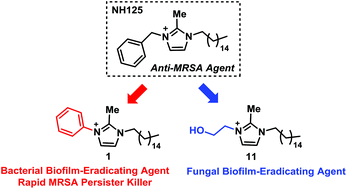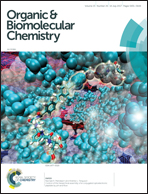Antimicrobial peptide-inspired NH125 analogues: bacterial and fungal biofilm-eradicating agents and rapid killers of MRSA persisters†
Abstract
During microbial infection, antimicrobial peptides are utilized by the immune response to rapidly eradicate microbial pathogens through the destruction of cellular membranes. Inspired by antimicrobial peptides, quaternary ammonium cationic (QAC) compounds have emerged as agents capable of destroying bacterial membranes leading to rapid bacterial death, including the eradication of persistent, surface-attached bacterial biofilms. NH125, an imidazolium cation with a sixteen membered fatty tail, was recently reported to eradicate persister cells and was our starting point for the development of novel antimicrobial agents. Here, we describe the design, chemical synthesis and biological investigations of a collection of 30 diverse NH125 analogues which provided critical insights into structural features that are important for antimicrobial activities in this class. From these studies, multiple NH125 analogues were identified to possess potent antibacterial and antifungal activities, eradicate both bacterial and fungal biofilms and rapidly eradicate MRSA persister cells in stationary phase. NH125 analogues also demonstrated more rapid persister cell killing activities against MRSA when tested alongside a panel of diverse membrane-active agents, including BAC-16 and daptomycin. NH125 analogues could have a significant impact on persister- and biofilm-related problems in numerous biomedical applications.



 Please wait while we load your content...
Please wait while we load your content...